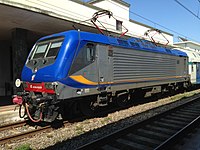
Photo from wikipedia
Abstract European energy policy encourages the railway stakeholders to adopt technological solutions to reduce the railway transport emissions by 50% within 2030. To this aim, the dynamic braking combined with… Click to show full abstract
Abstract European energy policy encourages the railway stakeholders to adopt technological solutions to reduce the railway transport emissions by 50% within 2030. To this aim, the dynamic braking combined with the adoption of reversible substations is one of the most promising solutions. To deepen the knowledge of this new technology in its practical application, this paper presents the results of a measurement campaign that has been conducted on-board of a train operating on the metro line that serves the city of Madrid, where a reversible substation was installed. The installed measurement system allows the accurate measurements of the energy flows and the losses. The monitoring has been performed both when the substation acts as reversible and when operates in a traditional way. The comparison could be used to quantify the impact of these technologies in a real application, providing information on energy saving in the different operating conditions and presenting a methodology to quantify them.
Journal Title: Measurement
Year Published: 2021
Link to full text (if available)
Share on Social Media: Sign Up to like & get
recommendations!